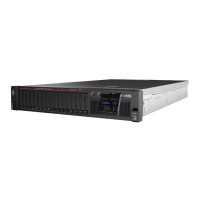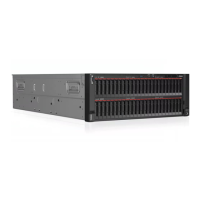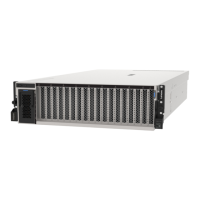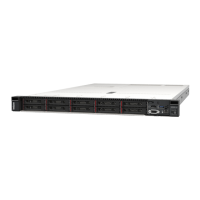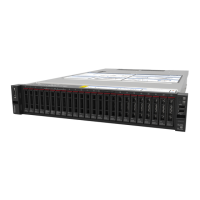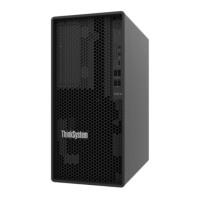3. Check the POST error log:
• If a memory module was disabled by a systems-management interrupt (SMI), replace the memory
module.
• If a memory module was disabled by the user or by POST, reseat the memory module; then, run the
Setup utility and enable the memory module.
4. Run memory diagnostics. When you start a solution and press F1, the Lenovo XClarity Provisioning
Manager V3 interface is displayed by default. You can perform memory diagnostics with this interface.
From the Diagnostic page, go to Run Diagnostic ➙ Memory test or PMEM test.
Notes: When PMEMs are installed, run diagnostics based on the mode that is set presently:
• App Direct Mode:
– Run Memory Test for DRAM memory modules.
– Run PMEM Test for PMEMs.
5. Reverse the modules between the channels (of the same processor), and then restart the server. If the
problem is related to a memory module, replace the failing memory module.
6. Re-enable all memory modules using the Setup utility, and then restart the server.
7. (Trained technician only) Install the failing memory module into a memory module connector for
processor 2 (if installed) to verify that the problem is not the processor or the memory module connector.
8. (Trained technician only) Replace the system board.
Multiple memory modules in a channel identified as failing
Note: Each time you install or remove a memory module, you must disconnect the server from the power
source; then, wait 10 seconds before restarting the server.
Complete the following procedure to solve the problem.
1. Reseat the memory modules; then, restart the server.
2. Remove the highest-numbered memory module of those that are identified and replace it with an
identical known good memory module; then, restart the server. Repeat as necessary. If the failures
continue after all identified memory modules are replaced, go to step 4.
3. Return the removed memory modules, one at a time, to their original connectors, restarting the server
after each memory module, until a memory module fails. Replace each failing memory module with an
identical known good memory module, restarting the server after each memory module replacement.
Repeat step 3 until you have tested all removed memory modules.
4. Replace the highest-numbered memory module of those identified; then, restart the server. Repeat as
necessary.
5. Reverse the memory modules between the channels (of the same processor), and then restart the
server. If the problem is related to a memory module, replace the failing memory module.
6. (Trained technician only) Install the failing memory module into a memory module connector for
processor 2 (if installed) to verify that the problem is not the processor or the memory module connector.
7. (Trained technician only) Replace the system board.
Extra namespace appears in an interleaved region
If there are two created namespaces in one interleaved region, VMware ESXi ignores the created
namespaces and creates an extra new namespace during system booting. Delete the created namespaces
in either the Setup Utility or the operating system before the first booting with ESXi.
238
ThinkSystem SR850 V2 Maintenance Manual

